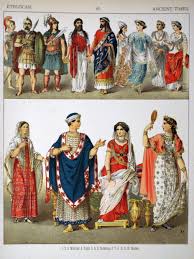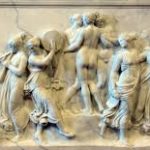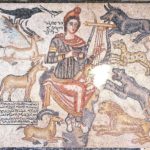Ancient Roman Costumes and Garments: The needles of the day were coarse and unwieldy by modern standards. Hence any stitching or sewing was kept to a minimum.
This of course also ruled out buttonholes and meant that any kind of clothing was held together either with fastenings such as broaches or clasps.

Ancient Roman Costumes – Toga
The classic toga was a distinct Roman garment that only actual citizens were allowed to wear. Its distinct purpose was to indicate peaceful endeavors, as opposed to the sagum cloak, worn during times of war.
The toga was a large cumbersome robe like a garment of white wool and used up to 9 yards of material. Being such a bulky and uncomfortable article of clothing, it became customary in later times to wear it only on state occasions.
Ancient Roman Costumes- male tunic
The male tunic would generally reach roughly to the knees, whereas women’s tunics would generally be longer, some reaching to the ground. Female tunics often also had long sleeves. However, it took until the second or third century AD for long sleeves to become acceptable for men. Until then it was perceived as highly effeminate to be wearing one.
The richest form of the long-sleeved tunic, the dalmatic, in many cases replaced the toga altogether in the later years of empire. In the very same age, due to the influence of Germanic soldiers dominating the ranks of the army, long, close-fitting trousers were widely worn.
Ancient Roman Costumes – women tunica
Roman women also wore tunica in much the same fashion as the men. There were two types, both adapted from Greek fashion. One, the peplos was made from two rectangular pieces of cloth partially sewn together on both sides with the open sections at the top folded down in the front and back.
It was pulled over the head and fastened with two large pins, forming a sleeveless dress. A belt was then tied over or under the folds.
Ancient Roman Costume: Stola
The Stola was probably similar in cut to the Tunica. The arm openings would be deeper, open to the waist. Sometimes the material was gathered at the shoulder seam to show the sleeves of the Tunica underneath. These pleats would be held together by pins, or by sewing a strip of braid over the seam, as on this statue.
The Stola would be more colorful and luxurious materials than the Tunica.
Ancient Roman Costume: Palla:
The Palla is a simple rectangular drape worn for modesty and protection from the elements. It could be worn on the shoulders as shown or drawn over the head. Use a full width of cloth, and hem or just fringe the ends to prevent fraying.



